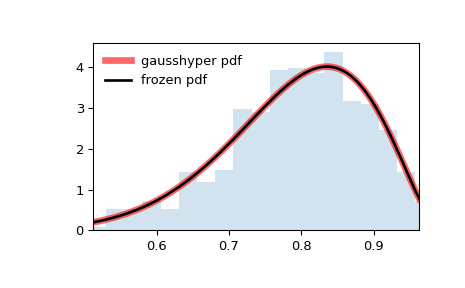scipy.stats.gausshyper — SciPy v1.16.0 Manual (original) (raw)
scipy.stats.gausshyper = <scipy.stats._continuous_distns.gausshyper_gen object>[source]#
A Gauss hypergeometric continuous random variable.
As an instance of the rv_continuous class, gausshyper object inherits from it a collection of generic methods (see below for the full list), and completes them with details specific for this particular distribution.
Methods
Notes
The probability density function for gausshyper is:
\[f(x, a, b, c, z) = C x^{a-1} (1-x)^{b-1} (1+zx)^{-c}\]
for \(0 \le x \le 1\), \(a,b > 0\), \(c\) a real number,\(z > -1\), and \(C = \frac{1}{B(a, b) F[2, 1](c, a; a+b; -z)}\).\(F[2, 1]\) is the Gauss hypergeometric functionscipy.special.hyp2f1.
gausshyper takes \(a\), \(b\), \(c\) and \(z\) as shape parameters.
The probability density above is defined in the “standardized” form. To shift and/or scale the distribution use the loc and scale parameters. Specifically, gausshyper.pdf(x, a, b, c, z, loc, scale) is identically equivalent to gausshyper.pdf(y, a, b, c, z) / scale withy = (x - loc) / scale. Note that shifting the location of a distribution does not make it a “noncentral” distribution; noncentral generalizations of some distributions are available in separate classes.
References
[1]
Armero, C., and M. J. Bayarri. “Prior Assessments for Prediction in Queues.” Journal of the Royal Statistical Society. Series D (The Statistician) 43, no. 1 (1994): 139-53. doi:10.2307/2348939
Examples
import numpy as np from scipy.stats import gausshyper import matplotlib.pyplot as plt fig, ax = plt.subplots(1, 1)
Get the support:
a, b, c, z = 13.8, 3.12, 2.51, 5.18 lb, ub = gausshyper.support(a, b, c, z)
Calculate the first four moments:
mean, var, skew, kurt = gausshyper.stats(a, b, c, z, moments='mvsk')
Display the probability density function (pdf):
x = np.linspace(gausshyper.ppf(0.01, a, b, c, z), ... gausshyper.ppf(0.99, a, b, c, z), 100) ax.plot(x, gausshyper.pdf(x, a, b, c, z), ... 'r-', lw=5, alpha=0.6, label='gausshyper pdf')
Alternatively, the distribution object can be called (as a function) to fix the shape, location and scale parameters. This returns a “frozen” RV object holding the given parameters fixed.
Freeze the distribution and display the frozen pdf:
rv = gausshyper(a, b, c, z) ax.plot(x, rv.pdf(x), 'k-', lw=2, label='frozen pdf')
Check accuracy of cdf and ppf:
vals = gausshyper.ppf([0.001, 0.5, 0.999], a, b, c, z) np.allclose([0.001, 0.5, 0.999], gausshyper.cdf(vals, a, b, c, z)) True
Generate random numbers:
r = gausshyper.rvs(a, b, c, z, size=1000)
And compare the histogram:
ax.hist(r, density=True, bins='auto', histtype='stepfilled', alpha=0.2) ax.set_xlim([x[0], x[-1]]) ax.legend(loc='best', frameon=False) plt.show()
